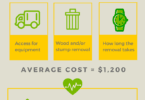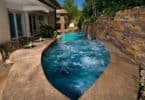Testing pool chemistry has come into the twenty-first century in recent years with the advent of electronic pool water testing kits. Most people, however, still use the old-fashioned liquid drops method. No matter their form, all basic kits test for total chlorine, total bromine, acid requirement, pool water pH, and total alkalinity. All of these chemicals work together to create a healthy harmony in your pool.
The pH of a swimming pool should be between 7.0-7.6. Water pH levels tend to naturally rise to 8.5. Swimming pool pH levels are also raised by regular swimming and environmental factors. If the pH of a pool is too low, the water will be too acidic. This will negatively affect chlorine evaporation rates of a pool. Chlorine is far more effective at water sanitation when the swimming pool water pH is at 7.2 rather than at a 8.0 or more. High pH promotes the growth of algae. Common algaecides, such as muriatic acid and sodium bisulphate, are used to reduce high pH levels. Low pH levels are treated with the addition of soda ash or sodium carbonate.
Adding chlorine purifies water. It also retards the growth of algae and prevents viruses and bacteria. Too high a chlorine level can cause swimmer eye and skin irritation. Along with its health risks to humans caused by viruses and bacteria, too little chlorine can also cause damage to the structure of a swimming pool.
Chlorine is very unstable and is readily broken down into inactive elements, so it is sometimes necessary to add a stabilizer, cyanuric acid, to a swimming pool. Cyanuric acid is a compound which protects swimming pool chlorine levels from UV and heat breakdown. It also reduces the amount of chlorine necessary for the pool. Stabilizer should be kept at a level of approximately 50 parts per million. If a stabilized chlorine product is in use, additional stabilizer is seldom necessary.
If chlorine cannot be used in a swimming pool, as in the case of skin sensitivity, the addition of bromine is sometimes suggested, as it is less irritating to skin. Bromine occurs naturally in sea water. Its use is more common in spas than in swimming pools.
Flocculant can also be used to clear cloudy water created by any microscopic particles missed by filtration. Flocculants induce flocculation. This is the process by which fine particulates aggregate together into “floc.” The floc may then be separated out and removed from the pool water by the pool’s filtration system.
Pool chemicals must be used with caution. They are caustic enough to kill algae. They can easily injure unwary users.
Always add chemicals to water and never water to chemicals. Package directions should be followed regarding the amount of time which must be elapsed after using the chemicals and before swimming in the pool. Never mix chemicals together unless specifically directed to do so.
With the use of modern pool technology, safe swimming water is dependably achieved and easily maintained. It’s just a matter of chemistry.
Related Articles:
eHow: Swimming Pool Chemical Safety
<>







